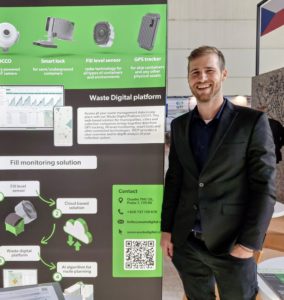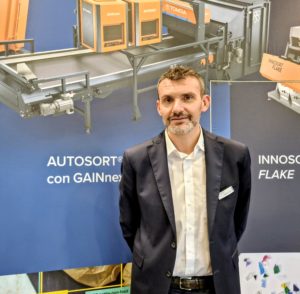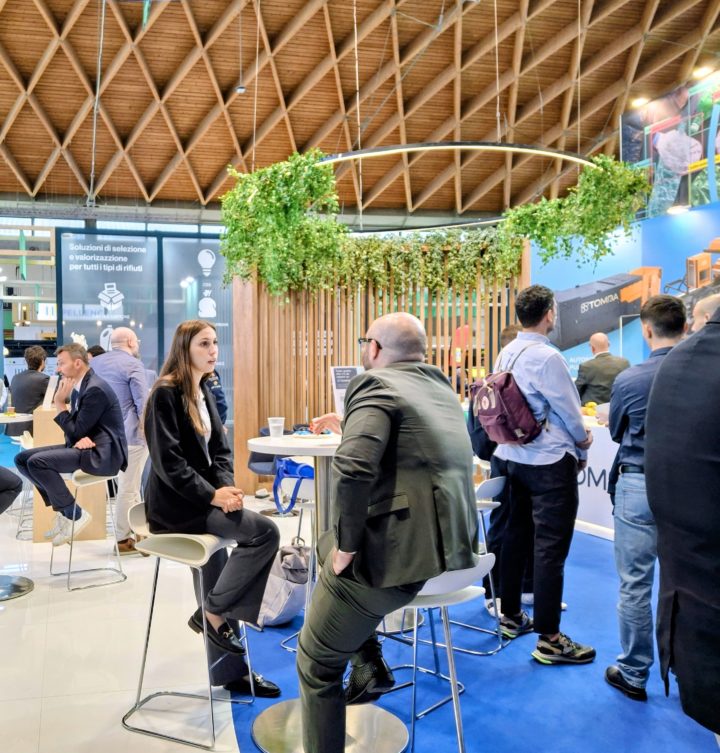At this year’s Ecomondo fair, two radically different approaches offered glimpses into how data, automation, and artificial intelligence are transforming waste handling. While one focuses on infrastructure-level digitalization, the other targets granular sorting precision. Both point toward the same goal: cutting inefficiencies, reducing environmental impact, and lowering operational risk in waste management.
Text and photos: Mia Heiskanen for Maintworld magazine
Traditional waste collection still dominates in much of Europe. The usual approach? Trucks follow static schedules, emptying every bin regardless of whether it’s full. This leads to wasted fuel, unnecessary emissions, and operational blind spots. I had an interesting conversation with Waste Digital with a simple proposition: digitize the system to make smarter decisions.
At the core of their solution are fill-level sensors placed inside waste containers. These sensors transmit real-time data on how full each bin is, enabling waste collection routes to be dynamically optimized. The result? Fewer unnecessary stops, up to 25% savings in fuel and kilometers driven, and reduced cost to cities that are billed per bin emptied.
But the system doesn’t stop there. For areas plagued by unauthorized dumping, Waste Digital offers smart locks with NFC-based access. Only residents or businesses with digital credentials can open the bins. This prevents cross-district misuse and enforces accountability.
Then there’s GPS tracking for large industrial containers which are especially relevant for construction firms or event operators managing dozens or hundreds of mobile units. The old method of Excel sheets and guesswork often leads to lost assets. With embedded trackers, companies get live location data for every container in their fleet.
“The old method of Excel sheets and guesswork often leads to lost assets.”
Perhaps the most eye-catching development is an AI-powered camera system that monitors container surroundings. Deployed in cities like Prague, the cameras periodically scan waste zones. If they detect trash piling up outside containers, alerts are sent automatically to clean-up crews. The aim is to preserve urban cleanliness and tackle illegal dumping before it becomes a problem.
For maintenance teams, these technologies offer clear operational upsides:
- Fewer breakdowns due to inefficient overuse of vehicles
- Faster diagnostics and route adjustments based on real-time conditions
- Preventive maintenance insights from container usage patterns
- Centralized control of distributed assets
As Waste Digital sees it, the future of waste logistics is fully autonomous where daily routes are planned algorithmically, downloaded to trucks, and executed with minimal human intervention. And it’s not a distant future.
-We’re already seeing 25 % cost and fuel savings where these systems are deployed. Scale that across a country, and the impact becomes huge, said Ing. Jan Grossmann at the stand.

AI That Thinks in Recyclables
If Waste Digital is about big-picture infrastructure, Tomra is about fine-tuning the mechanics of sorting down to the label on a milk bottle.
At Ecomondo, Tomra unveiled two new technologies: the FINDER™ COLOR system for metals, and GAINnext™, an AI-powered upgrade for waste sorting. Both are designed to make existing sorting systems smarter, not just faster.
FINDER™ COLOR , aimed at the metal division, enhances object identification based on color recognition — a critical detail for separating different metals more precisely.
The real leap, though, comes with GAINnext™ which is a deep-learning system that allows sorting machines to “memorize” specific waste items using visual data. Different countries may use the same materials but package them differently. A milk carton in Italy doesn’t look like one in Germany. Tomra’s solution compensates for this by learning those local patterns and adapting accordingly.
When added to Tomra’s existing auto-sort systems, GAINnext™ reportedly boosts sorting accuracy by 5–8%, enough to significantly reduce reliance on manual sorting labor. -The real gain, said Marco Niboli, Regional Sales Director for South-West Europe, is in achieving a fully automated line. You can eliminate manual pickers at the end of the process.

From a maintenance and operational standpoint, this is more than a technical upgrade:
- Less manual labor means fewer injury risks and lower personnel overhead.
- More consistent output reduces the risk of contaminated recycling batches.
- Customized AI models ensure performance even with country-specific waste streams.
- Reliability matters. Niboli noted that customers can issue penalties if sorting efficiency falls below promised thresholds.
That last point is crucial. In today’s tight-margin recycling market, even a few percentage points can make or break profitability. Poor performance doesn’t just mean inefficiency it can mean contractual losses. That’s why Tomra updates GAINnext™ algorithms weekly, ensuring the AI stays aligned with shifting customer needs and waste profiles.
Waste as a Strategic Asset
For industrial operators, these aren’t just feel-good sustainability stories. They’re about efficiency, asset management, and resilience. The maintenance landscape is shifting not just from reactive to predictive, but toward strategic automation powered by data and AI.
“Waste management is no longer an afterthought but a core operational pillar with bottom-line implications.”
Whether it’s reducing truck miles through smart sensors or squeezing more accuracy out of automated sorters, the direction is clear: waste management is no longer an afterthought but a core operational pillar with bottom-line implications. As cities and industries wrestle with stricter regulations and rising costs, the message from Rimini is unmistakable: the tools to fix waste are here. The question now is how fast we can put them to work.


